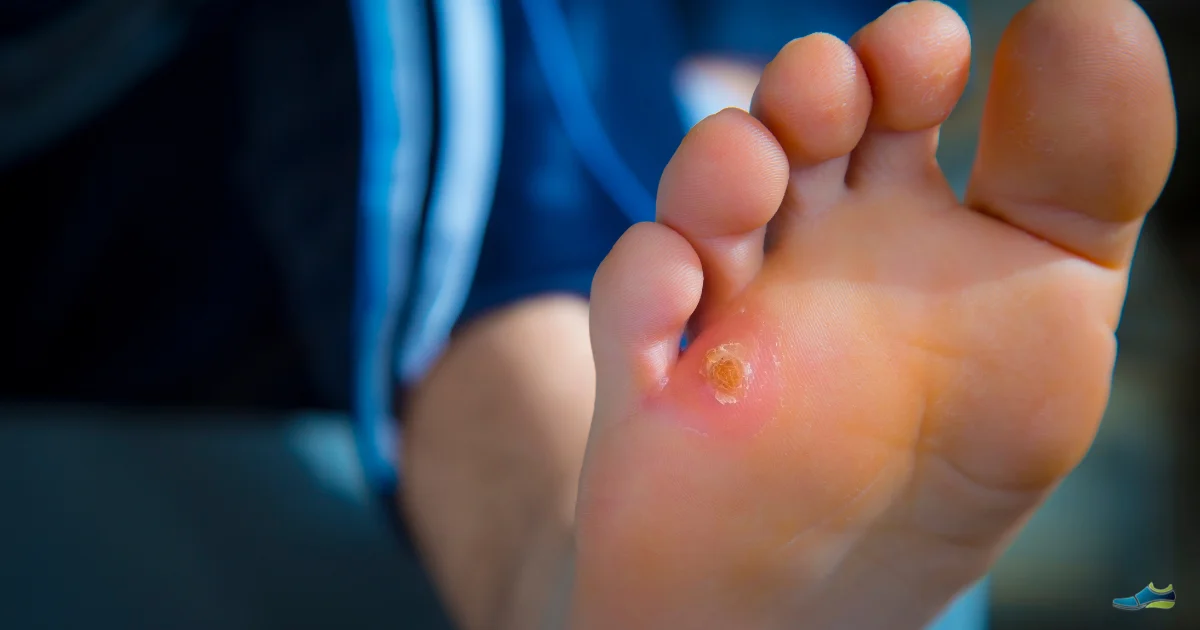Corns might be tiny, but they can make walking feel like torture. They’re a classic sign that your footwear and your feet are having an argument — and your toes are losing. The good news? With the right knowledge (and the right shoes), corns are manageable and often preventable.
💡 Quick Answers Available
Want the short version? Check out our Corns Info Bytes for 20 fast answers to the most common corns questions.
In this guide, we’ll cover what corns are, why they appear, how to get rid of them, and how to stop them from coming back.
What Are Corns on Feet?
Corns are small, thickened areas of skin that develop when your skin tries to protect itself from pressure or friction. They usually appear on the tops and sides of toes, or in between them.
Unlike calluses (which are larger and flatter), corns have a hard centre and can feel like you’re walking with a pebble in your shoe.
Causes and Risk Factors
- Shoes that are too tight, narrow, or have a pointed toe box
- High heels that force toes into cramped positions
- Seams, stitching, or straps rubbing on the skin
- Foot deformities like hammertoes or bunions
- Going sockless in shoes that rub
People with reduced fat padding in their feet (common with age) are more prone to corns.
Symptoms and How to Recognise Them
Corns can be:
- Hard corns — firm, dense, usually on the tops of toes or where shoes rub
- Soft corns — rubbery, often between toes where skin stays moist
- Seed corns — tiny and tender, often on the sole
Common signs include localised pain when walking or wearing certain shoes, a raised bump of hard skin with a dense centre, and sometimes redness or swelling if irritated.
How Footwear Plays a Role
Footwear is the single biggest factor in both the formation and prevention of corns. Shoes that squeeze the toes, have a narrow toe box, or create rubbing points quickly lead to pressure spots.
Switch to shoes with a wide, rounded toe box, soft seamless interiors, and the proper width fitting to dramatically reduce friction and pressure.
Treatment Options
At‑home care
- Soak feet in warm water to soften skin
- Gently file with a pumice stone (never cut)
- Use cushioned corn pads to reduce pressure
- Moisturise daily to keep skin supple
Footwear changes
- Choose shoes with adequate width and depth
- Avoid high heels and pointed toes
- Use cushioned insoles to reduce pressure
Professional care
- Podiatrists can safely remove corns and address underlying causes
- Custom orthotics may be recommended for uneven weight distribution
Prevention Tips
- Measure feet regularly — size can change over time
- Wear socks that reduce friction (moisture‑wicking blends)
- Alternate shoes to avoid constant pressure in the same spots
- Break in new shoes gradually
Best Shoes for Corns
The ideal shoe will have:
- Wide toe box so toes aren’t squashed
- Soft lining with no rough seams over pressure points
- Good cushioning under the ball of the foot and toes
- Low to moderate heel height to avoid excessive forefoot pressure
When to See a Doctor or Podiatrist
- Corns are very painful or keep returning
- You have diabetes or poor circulation
- Signs of infection: redness, swelling, discharge
FAQs
Q: Are corns contagious?
A: No — corns are caused by pressure or friction, not infection.
Q: Can I cut out a corn myself?
A: No — this risks infection. See a podiatrist for safe removal.
Q: How long do corns take to go away?
A: If you remove the source of pressure, a corn may improve within a few weeks. Without addressing the cause, it will return.
Q: Do corn plasters work?
A: They can help soften a corn, but won’t stop it returning unless the shoe‑fit issue is fixed.
Related Reading
- Corns Info Bytes (quick Q&A)
- Wide Fit Shoe Buying Guide
Corns are a warning sign that your shoes aren’t working with your feet. With the right footwear, a little care, and professional help when needed, you can walk comfortably again. Don’t just treat the corn — fix the cause.

